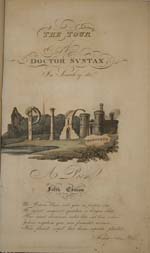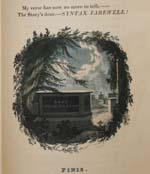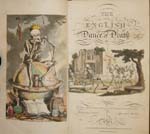Thomas Rowlandson
Thomas Rowlandson (1757-1827) showed early talent as an artist, and became a student the Royal Academy Schools in 1772, where, unusually, he developed as a draughtsman and not a painter. Rowlandson's work is sometimes compared to that of William Hogarth as they were both great social commentators and caricaturists.
Although principally a caricaturist, Rowlandson had a great range of interests and extraordinary range as an artist. A specialist in urban topography, he was a portraitist, social commentator, and sporting artist. A well-known gambler, Rowlandson was familiar with the seamy side of London he portrayed. He reveled in the comedy of everyday life, emphasizing the ridiculous and the ribald, poking fun while avoiding emotion and satire. His story-telling is often based on human appetites such as eating, drinking, and amorous relationships. His landscapes tend to be rococo; he was not an architectural draftsman and was often bored by detail. Rowlandson could extract comedy from any situation, but it was the comedy of everyday life that interested him most.
Rudolph Ackermann was Rowlandson's most important patron. Ackermann first employed Rowlandson in 1798 and the relationship continued for 25 years. It was also through Ackermann that Rowlandson met William Combe, who would write the Dr. Syntax books and become Rowlandson's most successful collaborator. Rowlandson's illustrations for color plate books represent only a small part of his output.

This book marked the beginning of one of the most important collaborations in color plate books, that of William Combe and Thomas Rowlandson. They were brought together by Rudolph Ackermann, who published their collaborations; Dr. Syntax first appeared in his Poetical Magazine. Rowlandson did the illustrations before any text was thought of, and Combe described his work on the books in the Advertisement:
an etching or drawing was sent me every month, and I composed a certain proportion of pages in verse, in which, of course, the subject of the design was included: the rest depended on what my imagination could furnish. When the first print was sent to me I did not know what would be the subject of the second; and in this manner, in a great measure, the artist continued designing, and I continued writing every month for two years. (ii-iii)
The text combines satire on popular contemporary theories of the picturesque with the adventures of a picaresque hero in the vein of Don Quixote.

The success of The Tour of Doctor Syntax was so great that a sequel was published at Ackermann's urging. The drawings of Dr. Syntax also influenced fashion, as people bought Dr. Syntax hats, wigs, and coats. The premise of this second story is that Dr. Syntax's wife has died, and he undertakes his travels "in search of consolation."

The first two Dr. Syntax books were quickly followed with this third volume, describing Dr. Syntax's search for a new wife, with the expected comic incidents. At the end of the volume the industrious hero dies, thus ruling out any further sequels.

Undoubtedly the best book to emerge from Combe and Rowlandson's collaboration. Combe's verse here is unusually good and full of wit, and Rowlandson seems to have taken exceptional time and care on these illustrations. The theme of death reaching out to seize his prey at any moment had been portrayed by many other artists, most notably Hans Holbein. Rowlandson's illustrations are a characteristic combination of the sublime and the ludicrous, the gruesome and the grotesque.

This companion volume to The English Dance of Death has illustrations satirizing life and its follies. Although amusing and inventive, it does not reach the level of the Dance of Death.
